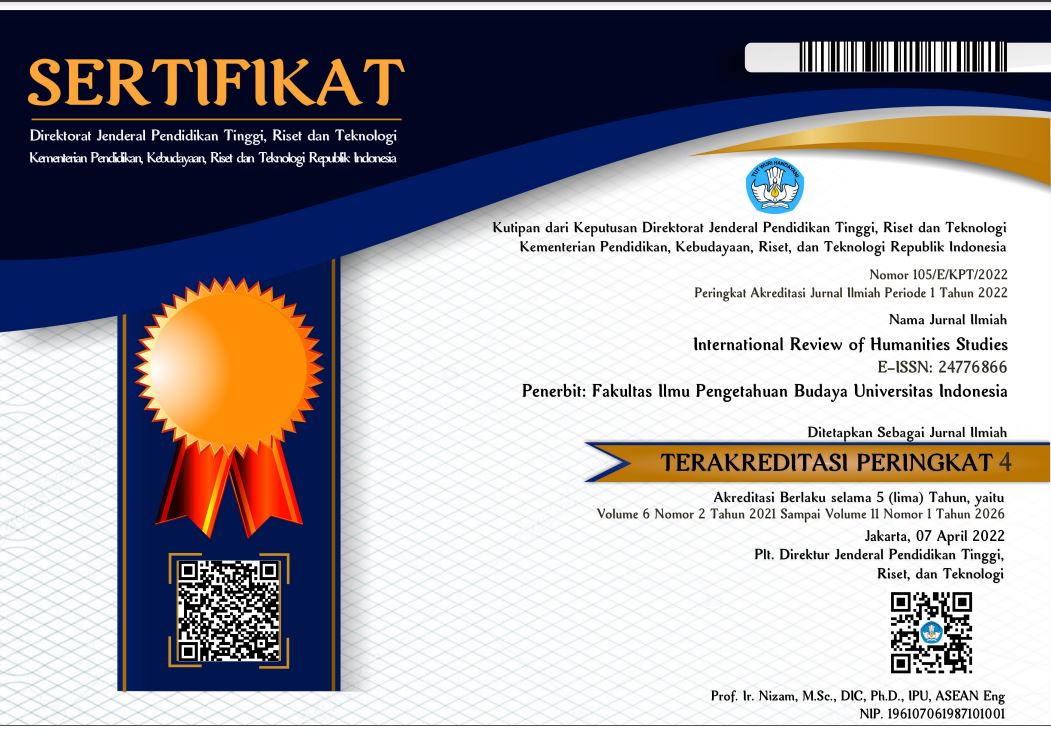International Review of Humanities Studies

Abstract
This research discusses the meaning and function of the natural environment in one folk tale that is well known in the Javanese community. This folktale is known in all circles of society, despite having social differences. An interesting problem in this folklore is the placement of functions and environmental meanings as the main elements of stories or tales. The focus of this research is to raise the function and meaning of the natural environment contained in one story of Keong Mas. This study aims to explain carefully the function and meaning of the natural environment which is the background of a fairy tale. The background story that uses the natural environment as the main object of the story often gets no attention. In the story of Keong Mas, it is precisely the setting that contains the natural environment that has functions and meanings that are very important to understand. This study uses a qualitative research paradigm procedure, which gives researchers the opportunity to interpret available data. The results of the study show that the story of Keong Mas is not just an ordinary folktale. Keong Mas folklore has a very specific story setting, which is a particular natural environment. Keong Mas or Pila ampullacea are animals that can live on land or in water. Rural communities who live on the banks of the river by cultivating crops such as rice, can find these types of animals around their environment. No wonder this animal is an inspiration to make a story in the background of the natural environment in the countryside
References
Margono, 2007, Manusia dan Lingkungan Budaya, Surabaya: Bintang Raya.
Danandjaja, James, 2009, Foklor Indonesia Ilmu Gosip dan Dongeng, Jakarta: Grafiti Press
Daryono, Ismail, 2005, Masyarakat dan Ketahanan Lingkungan Alam ,Semarang: Pustaka Ilmu.
Djuwita, Barsimal, 2003, Perkembang dan Struktur Cerita Sastra Lisan, Jakarta: Rajawali
Endraswara S, 2016, Memayu Hayuning Bawana, Jakarta: PT Buku Seru Garrard G, 2004, Ecocriticism, New York: Routledge
Hartato, Agus, 2010, Warisan Budaya Nusantara, Jakarta: Pelangi Pengetahuan.
Iskandar W., 2010, Pemanfaatan Lingkungan Dalam Cerita, Surabaya: Bintang Raya.
Keraf, Sonny, 2014, Filsafat Lingkungan Hidup, Yogyakarta: PT Kanisius
Kristuti, Indah, 2007, Dibalik Keindahan Sastra Lisan, Semarang: Dunia Ilmu Moleong,
Lexy J., 2011, Metode Penelitian Kualitataif, Bandung: Rosdakarya.
Nurgiyantoro, Burhan, 2002, Teori Pengkajian Fiksi, Yogyakarta: Gadjah Mada University Press.
Razak, Alina, 2006, Struktur Cerita Rakyat dan Nilai Budaya, Medan: Parigi Pengetahuan.
Retnowati and Endang Ernawati, 2017, Narratology and New Historicism In Keong Mas. Jakarta: Bina Nusantara (http://journal.binus.ac.id/index.php/Humaniora/article/view/3712)
Saidah, Nurul and Adi Nursito, 2013, Karakter Cerita dan Kearifan Lokal, Semarang: Pustaka Ilmu.
Setyoningsih, Irawati, 2009, Legenda Keong Mas Sebagai Sumber Ide Dalam Perancangan Motif Tekstil Untuk Pakaian Muslimah, Solo: Universitas Sebelas Maret. (https://eprints.uns.ac.id/4795/ )
Subekti, M., 2006, . Sudut Pandang Masyarakat Tradisional Dalam Kehidupan Keluarga Semarang: Dunia Ilmu
Warsidi, Achmad, 2009, Pengetahuan Tradisonal sebagai Warisan Budaya, Surabaya: Bintang Raya.
Recommended Citation
Utami, Adinda Bunga and Lestari, Nanny Sri
(2019)
"FUNCTION, MEANING, AND MESSAGE OF THE NATURAL ENVIRONTMENT IN THE STORY OF KEONG MAS,"
International Review of Humanities Studies: Vol. 4:
No.
2, Article 5.
Available at:
https://scholarhub.ui.ac.id/irhs/vol4/iss2/5
Included in
Arts and Humanities Commons, Engineering Commons, Life Sciences Commons, Physical Sciences and Mathematics Commons, Social and Behavioral Sciences Commons


